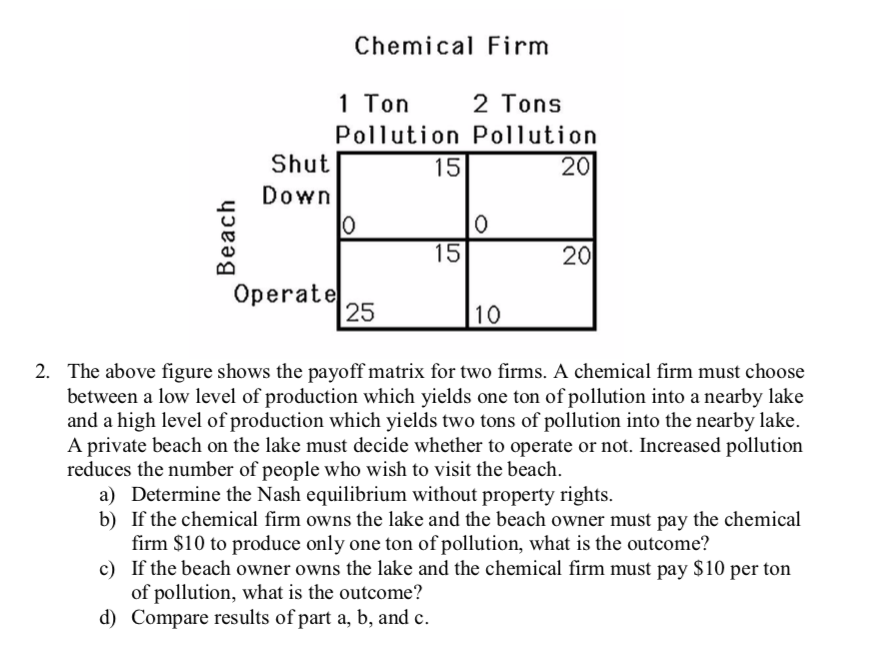2. The above figure shows the payoff matrix for two firms. A chemical firm must choose between a low level of production which yields one ton of pollution into a nearby lake and a high level of production which yields two tons of pollution into the nearby lake. A private beach on the lake must decide whether to operate or not. Increased pollution reduces the number of people who wish to visit the beach. a) Determine the Nash equilibrium without property rights. b) If the chemical firm owns the lake and the beach owner must pay the chemical firm $10 to produce only one ton of pollution, what is the outcome? c) If the beach owner owns the lake and the chemical firm must pay $10 per ton of pollution, what is the outcome? d) Compare results of part a, b, and c.
2. The above figure shows the payoff matrix for two firms. A chemical firm must choose between a low level of production which yields one ton of pollution into a nearby lake and a high level of production which yields two tons of pollution into the nearby lake. A private beach on the lake must decide whether to operate or not. Increased pollution reduces the number of people who wish to visit the beach. a) Determine the Nash equilibrium without property rights. b) If the chemical firm owns the lake and the beach owner must pay the chemical firm $10 to produce only one ton of pollution, what is the outcome? c) If the beach owner owns the lake and the chemical firm must pay $10 per ton of pollution, what is the outcome? d) Compare results of part a, b, and c.
Managerial Economics: A Problem Solving Approach
5th Edition
ISBN:9781337106665
Author:Luke M. Froeb, Brian T. McCann, Michael R. Ward, Mike Shor
Publisher:Luke M. Froeb, Brian T. McCann, Michael R. Ward, Mike Shor
Chapter16: Bargaining
Section: Chapter Questions
Problem 16.1IP
Related questions
Question
Dear tutor, please solve all the parts of the question as very clear and detailed. THANK YOU SO MUCH!!! (ESPECIALLY PART C AND D ARE VERY IMPORTANT FOR ME) THANK YOU...

Transcribed Image Text:Chemical Firm
1 Ton
Pollution Pollution
2 Tons
Shut
15
20
Down
15
20
Оperatel
25
10
2. The above figure shows the payoff matrix for two firms. A chemical firm must choose
between a low level of production which yields one ton of pollution into a nearby lake
and a high level of production which yields two tons of pollution into the nearby lake.
A private beach on the lake must decide whether to operate or not. Increased pollution
reduces the number of people who wish to visit the beach.
a) Determine the Nash equilibrium without property rights.
b) If the chemical firm owns the lake and the beach owner must pay the chemical
firm $10 to produce only one ton of pollution, what is the outcome?
c) If the beach owner owns the lake and the chemical firm must pay $10 per ton
of pollution, what is the outcome?
d) Compare results of part a, b, and c.
Beach
Expert Solution
This question has been solved!
Explore an expertly crafted, step-by-step solution for a thorough understanding of key concepts.
Step by step
Solved in 4 steps with 3 images

Knowledge Booster
Learn more about
Need a deep-dive on the concept behind this application? Look no further. Learn more about this topic, economics and related others by exploring similar questions and additional content below.Recommended textbooks for you

Managerial Economics: A Problem Solving Approach
Economics
ISBN:
9781337106665
Author:
Luke M. Froeb, Brian T. McCann, Michael R. Ward, Mike Shor
Publisher:
Cengage Learning


Managerial Economics: A Problem Solving Approach
Economics
ISBN:
9781337106665
Author:
Luke M. Froeb, Brian T. McCann, Michael R. Ward, Mike Shor
Publisher:
Cengage Learning
